 Don't push them 'cause they're close to the edge. 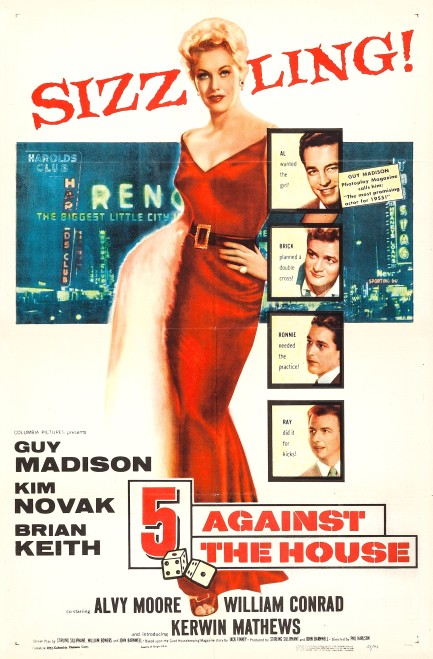
Sizzling is a good word for Kim Novak. In her fourth film, 5 Against the House, which premiered in the U.S. today in 1955, she wasn't quite a star yet, but her backers at Columbia Pictures had tabbed her for the Hollywood firmament. They placed her in this drama about a quartet of men who've spent a few years in the Korean War (Novak makes the 5 of the title but she spent that time on the home front) and are back to finish law school. Distressed by their lack of resources and opportunities, one of them, who's a gambler and dreamer, convinces two of the others they can rob a Reno casino. Guy Madison, top-billed, has no idea what's occurring, at least at first, and Novak plays his girlfriend and has even less of an idea. They figure it out, though, while the group are road-tripping to Nevada. Madison and Novak want out, but both are blackmailed into participating.
The movie has an interesting tone. They guys are all quipsters, and some of their Rat Pack interplay is legitimately funny, but their simmering disaffection eventually comes to the fore as they amp themselves up for the robbery by talking about all they've lost having been sent to war. Most of all, they've lost time. That idea makes narrative sense, but the actors are a little old for the roles. Madison, Alvy Moore, and Brian Keith are all in their mid-thirties. How long did they spend in Korea—a decade? Kerwin Matthews is twenty-nine, which maybe works, but Novak, as Madison's college sweetheart, is in her early twenties. How the hell did that happen? Did he start dating her when she was thirteen? Maybe their ages are minor points, but we noticed, and you will too.
In any case, the guys resent being years behind law students who avoided the war, and figure the country owes them something, even if it's only cash. Later, though, right when it looks like they might get smart and back out, Keith shows that he had a screw knocked loose by combat and manages to force the issue. The subsequent robbery involves fake mustaches and a misdirection play, but it's never the point. The movie is really a sympathy piece for the boys who fought overseas and a mild remark about the psychological cost of warfare. All fine, but—and it pains us to say this about any Novak movie—it's weak, entirely unrealistic, and climactically ludicrous. Ultimately, 5 Against the House is probably only worth seeing for the banter between the fellas, and a gander at captivating Kim. She's hotter than Reno in July. You can bet on it.
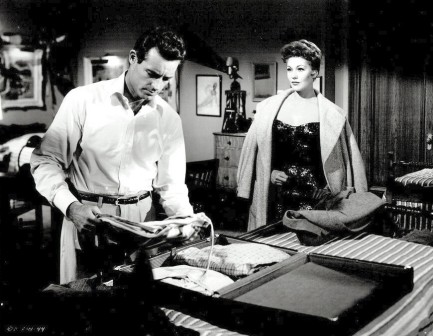 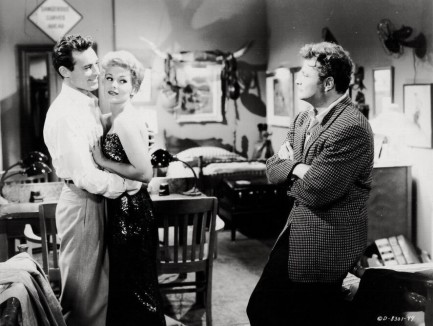 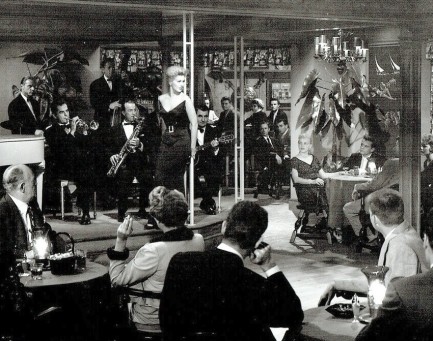 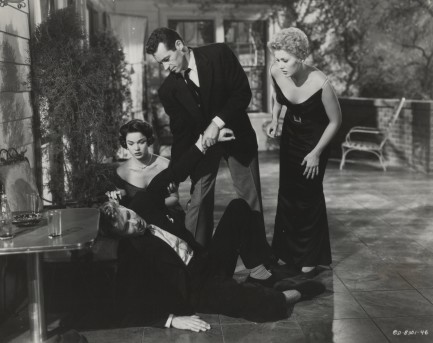 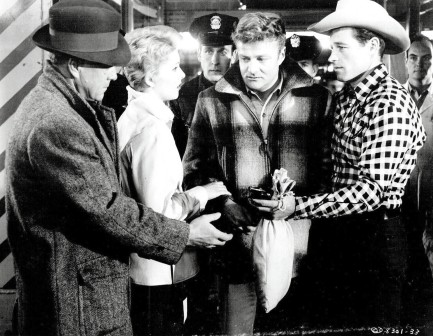   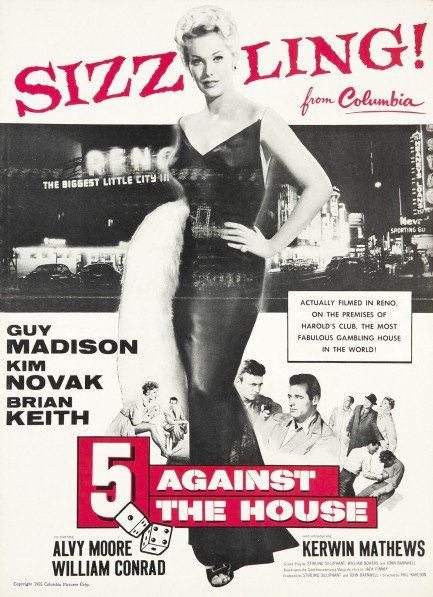
 1-2-0-0, party over, oops out of time. So tonight we're gonna party like it's 11:59. 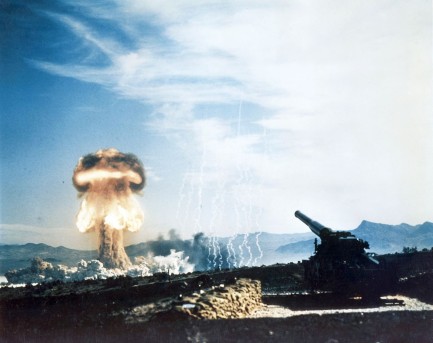
The Doomsday Clock is currently set at ninety seconds to midnight. That's not good. Here in the palatial Pulp Intl. metroplex we tend not to worry too much. For one, we're too focused on enjoying life. Second, we've always maintained that the only possible benefit to the ridiculous proliferation of the ultra wealthy is that none of them want to be incinerated, and they possibly have influence on countries' policies to a greater extent than at any previous time in history. On the other hand, humans are generally pretty stupid, running geopolitics like high school bullies, and there are many people who crave obliteration because of their bronze age religious myths. Some of those people are influential too.
So, in these moments when the spinning top of human civilization threatens to careen right off the tiny table on which it's perched, the above photo is a reminder to live your life to the fullest. It shows the nuclear test Grable, which was part of the series of tests nicknamed Operation Upshot-Knothole, and occurred at the Nevada Test Site today in 1953. They fired a 280 millimeter nuclear shell into the desert with the so-named M65 Atomic Cannon, detonating the explosive aerially, resulting in a 15 kiloton blast. And they proved... Well, we can't be sure about that. Multiple methods of doomsday delivery, possible delusions about contained nuclear warfare, etc. Dance, everyone. Just dance. 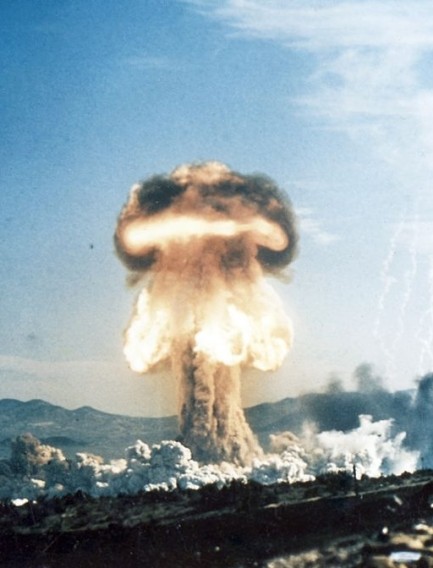
 There's no jealousy like a femme fatale's jealousy. 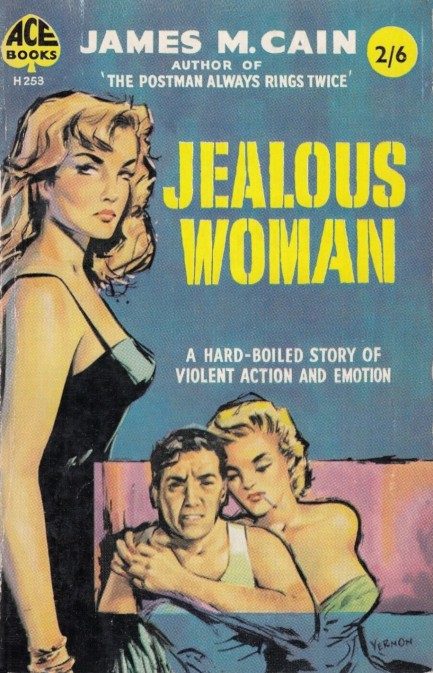
It's amazing how much easier James M. Cain makes writing seem than scores of other authors. His 1950 novel Jealous Woman starts at a gallop. Here's the first line: At the desk, when they said she was in 819, I knew hubby or pappy or somebody was doing all right by their Jane, because 19 is the deluxe tier at the Washoe-Truckee, one of our best hotels here in Reno, and you don’t get space there for buttons. And just like that we're off. Cain gives readers ambitious insurance man Ed Horner of General Pan-Pacific Insurance of California. Horner lives, works, and parties in Reno, where unhappy marrieds migrate to be freed from their nuptial bonds. He gets involved in a complex divorce/annulment scheme between Jane Delavan, her rich husband, Jane's ex-husband, and his current wife. Yes, it's a bit complicated, but a messy murder uncomplicates it a little. At least for readers. For Horner, things get weird. Jealous Woman isn't Cain's best, but it's still a slice of devious fun worth reading, and this Ace version with John Vernon cover art is the edition to buy if you can. 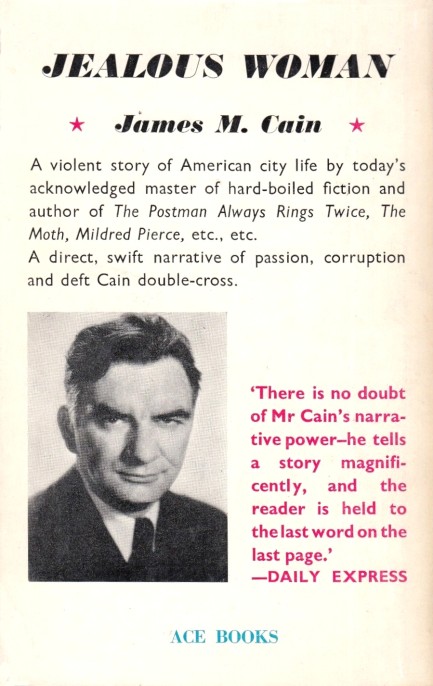
 Hey, should we put another log or two on the— Actually, never mind. It's going pretty good now. 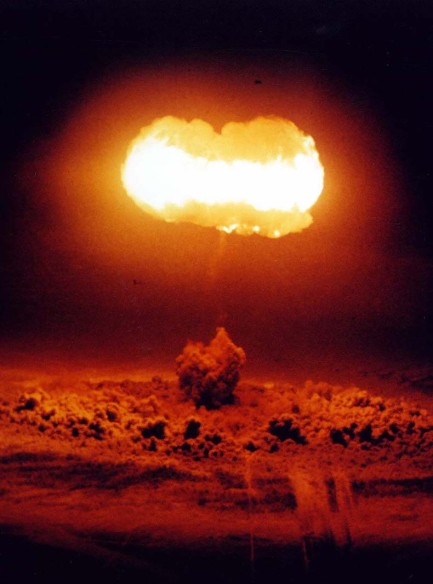
The Stokes nuclear test was part of the extensive series of blasts code-named Operation Plumbbob conducted at the Nevada Test Site, as the U.S. continued its race with the Soviet Union, seeking higher yielding, more efficient, and more specifically functional bombs. Stokes was a nineteen kiloton blast detonated with the use of an aerial balloon suspended at 1,500 feet. The result was one of the most reproduced photos of the nuclear testing age. From today in 1957.
 Rule No. 1 of military service: Never volunteer. 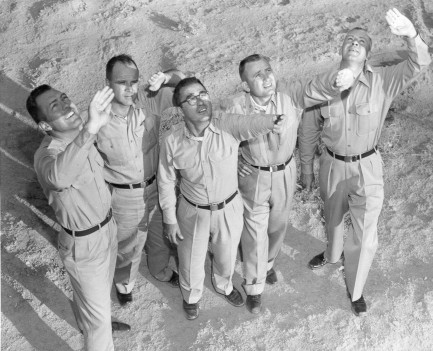
The moment you see this photo you know something bizarre and unique to the 1950s is going on. In what was conceived by Air Force brains as a public relations event, today in 1957 these five men (and the photographer) voluntarily located themselves beneath a nuclear detonation to demonstrate that atomic weapons were suitable for use over civilian populations. Yes, we know—if they don't kill people what's the point? Like we said, bizarre and unique to the ’50s. The U.S. would later design a neutron bomb that was 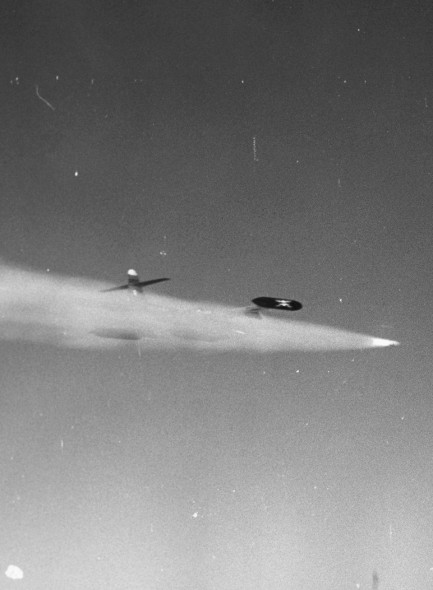 meant to kill only people and leave buildings and infrastructure intact, which makes sense in upside-down military world, but not killing people? We're baffled. meant to kill only people and leave buildings and infrastructure intact, which makes sense in upside-down military world, but not killing people? We're baffled.
The explosion, which was code-named John, was part of the Operation Plumbbob series of twenty-nine tests, and took place over Yucca Flat in Nevada at an altitude of 18,000 feet or thereabouts (some sources say 15,000). It was the first and only usage of a device known as the AIR-2 Genie, an airplane launched, rocket powered, unguided nuclear missile. We have no problem admitting they would have lost us at unguided. We wouldn't even be in the same time zone: “Okay, everyone ready? Good, we're counting down from— Hey, where'd those pulp guys go?” Did the test actually prove nuclear weapons were safe? They thought so. All five of the above guinea pigs lived for years beyond detonation day, but in a (not) shocking plot twist, all eventually died of cancer. The photographer, who was stationed a few feet higher than the other men, was incinerated. Oh, nope—actually he died of cancer too. You can watch the test at this link.
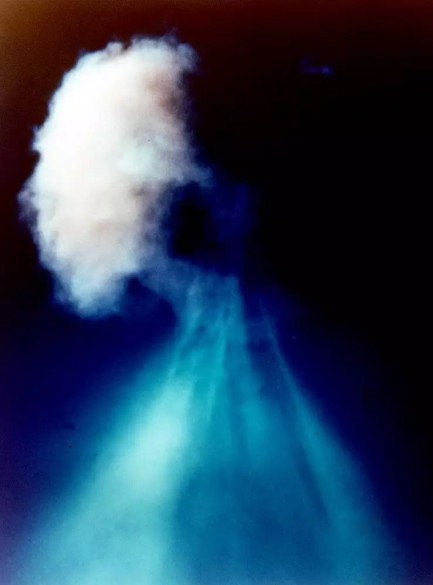
 On the first day of murder, my true love gave to me... 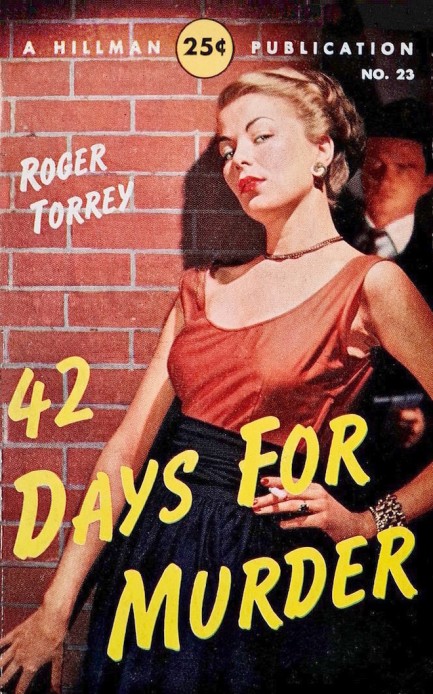
The 42 days of Roger Torrey's 42 Days for Murder refers to the six weeks that someone needed to be resident in Nevada to qualify for a divorce, which we think is kind of clever title-wise. The story deals with a rich man's wife who runs away to Reno to dissolve her marriage but goes incommunicado after she arrives. The husband hires a detective named Shean Connell to track down his wife so that he can at least talk to her before she ditches him. Finding her is not much of a problem for Connell. Arranging for his client to talk to her is another deal entirely. As the story unfolds, it turns out there's a reason for her reluctance to chat. A very good reason, actually, which Connell figures out only at the cost of considerable mayhem, two deadly shootouts, and a veritable pile of corpses.
The book was originally published in 1938, but this Hillman edition featuring a photo cover came in 1949. Torrey was an experienced writer, having produced stories for the pulp magazine Black Mask, and here he shows a deft hand with a unique idea that we can't even hint at without spoiling the book. Flaws include dialogue that sometimes stretches past the point of usefulness or interest—Torrey could have cut the book by twenty pages easily, if not thirty—but it remains a fun ride tearing around 1930's Reno with Connell, who's not only a shamus but an ace piano player. He's the best part of the novel, though he's unusually cynical about women. Too bad 42 Days for Murder was Torrey's only book. It's not perfect, but it's one to catch if you can.
 Climate change dredges up grim evidence of crimes thought long forgotten. 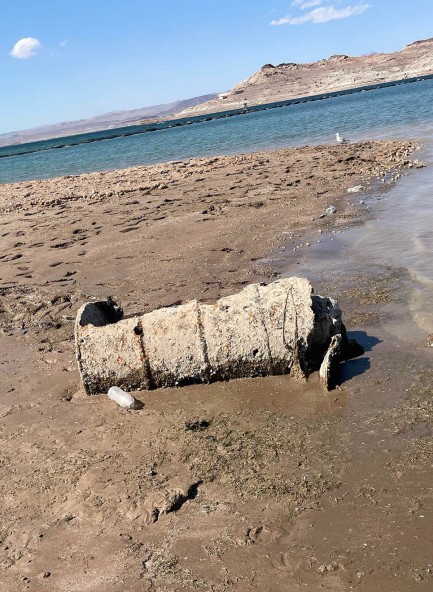
Earlier this week in Nevada, someone ambling along the shoreline of Lake Mead found a corroded oil drum that had a nasty surprise inside. Police determined that the contents were human remains, and that the poor individual died of a gunshot wound sometime in the mid-1970s to early 1980s. Whoever killed the person dumped the body deep into the lake—actually a huge reservoir formed by Hoover Dam—but because of an ongoing drought in the western states, the water has in recent years dropped more than a hundred feet below its maximum, revealing tracts of previously submerged land. Authorities believe that as the water level continues dropping they'll find more bodies. And why is that? Well, Las Vegas is nearby.
In a related story, somewhere in Sin City an elderly mobster awoke from an afternoon nap in a sweaty panic, put his hands to his painfully throbbing head, and said: “I felt a great disturbance in the Force. It's as if a voice I thought was silenced decades ago suddenly cried out in terror.” Silence doesn't always last. For sure that'll be the interesting part of this—seeing if modern forensics can identify the body, a good possibility considering the advances of recent decades. And of course identification might lead to suspicions about who dumped it.
The elderly mobster later phoned a slightly less elderly hitman and ranted, “You told me it'd never be found!” To which the hitman said, “Who am I? Nostra-fuckin'-damus? I'm supposed to know the goddamned lake's gonna dry up? You still getting chauffeured around in that old Cadillac? I got a hybrid, so don't blame me!” To the list of problems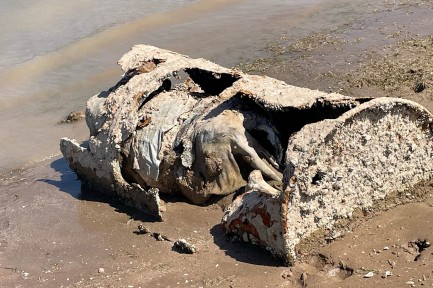 caused by global warming, add grisly corpses reappearing, and former hitmen virtue signaling about their carbon footprints. Which the mobster was too old to understand anyway. “Hybrid? You know I never worked with them! I never liked them, and I never trusted them!” caused by global warming, add grisly corpses reappearing, and former hitmen virtue signaling about their carbon footprints. Which the mobster was too old to understand anyway. “Hybrid? You know I never worked with them! I never liked them, and I never trusted them!”
Plenty of mob-connected people have disappeared from Las Vegas over the decades. As pulp aficionados we have to hope they're all in the lake. Seriously, wouldn't it be fantastic if like seventy bodies turned up? Meanwhile, we bet there's an uptick in local bottled water sales. While it's true the reservoir's output is purified before it gushes through city faucets, and the nuclear testing grounds and chemical plants scattered around Vegas have probably left worse than corpse pathogens in the lake, images of human remains tend to give people a special kind of willies. You can purify the water, but you can't purify people's natural fear of death and decay. Since nothing serious is actually being done about global warming, we at least recommend a more sustainable form of victim disposal. When trouble looms, hide the evidence better. It's time to innovate, Gen Z—older generations have failed. Edit: As of 7 August a total of four bodies have been found. More to come?
 For there were no more worlds to conquer. 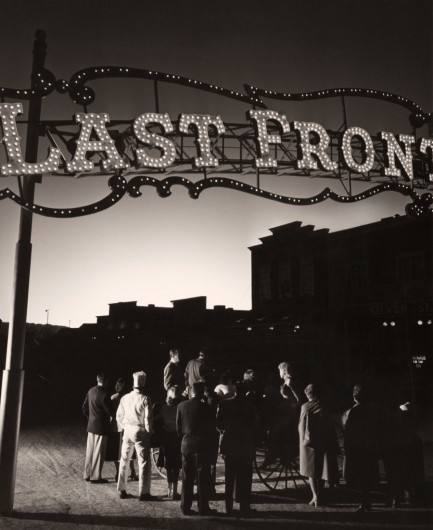
Above: a crowd of spectators standing under the entrance sign of the Last Frontier Village on the Las Vegas strip watch the flash from a nuclear blast emanating from the Nevada desert. In the immediate background are Old West-style buildings that housed shops, restaurants, and the Golden Slipper Casino. The sign is a nice juxtaposition by lensman Volkmar Wentzel, placing his shot at the nexus of visual metaphor and social commentary. The bomb, named Annie, was detonated at Yucca Flat at the Nevada Test Site as part of the test series Operation Upshot-Knothole. It was one of the most photographed of nuclear tests, which is why we've already touched on it here and here, and in fact, because the event was even documented on kinescope, it's one of the few recordings ever made of the sound of a nuclear explosion. Below you see what Annie looked like for people closer to ground zero. It happened early this morning in 1953.
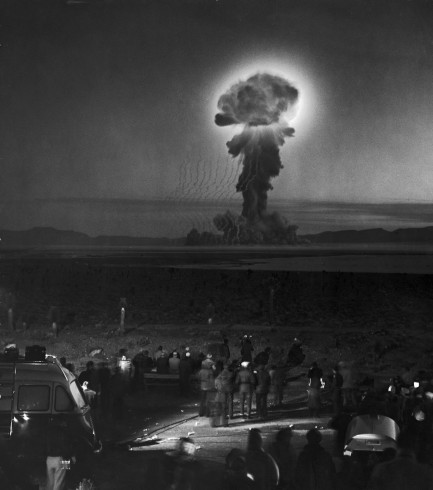
 It's not an arms race until there are fireworks. 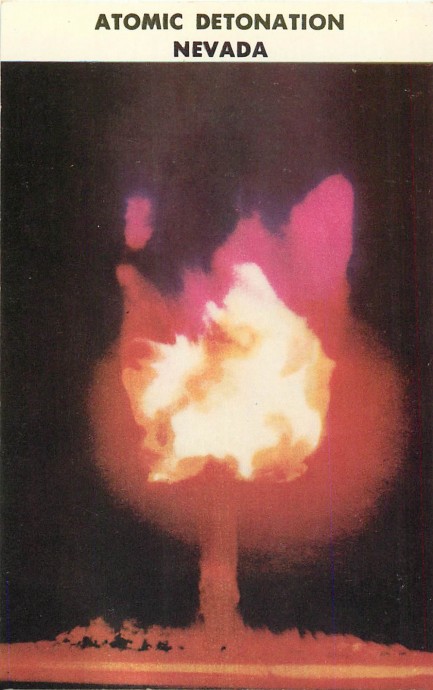
Proving once again that people will buy anything, especially if it's cheap, above you see a postcard depicting the nuclear test Fox, which was conducted as part of Operation Ranger today in 1951. The operation comprised five tests, all in aerial bomb form, dropped and detonated over Frenchman Flat test site in Nevada. The postcard was manufactured by the Desert Supply Co. of Las Vegas, which makes sense because this is exactly what happens to your wallet if you go to Vegas. Since the postcard image a a bit faded, below we have an actual shot of the test in all its insane crimson splendor. Only these devices have the ability to send civilization back to the stone age. Global warming, a pandemic, anything else you care to name, falls well short. And the nuclear arms race is ongoing, as several atomic powers are recklessly upgrading and expanding their arsenals. Want to see another interesting image of this event? Look here. 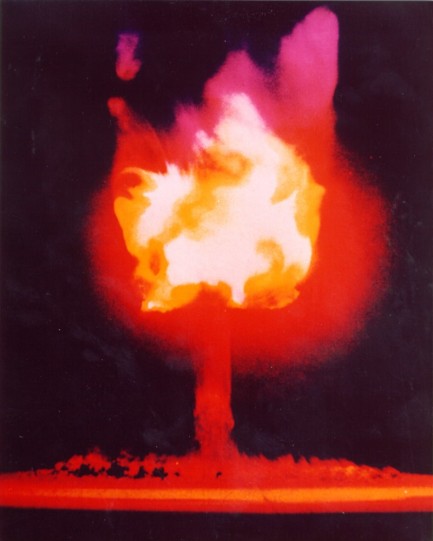
 Some encounters you remember better than others. 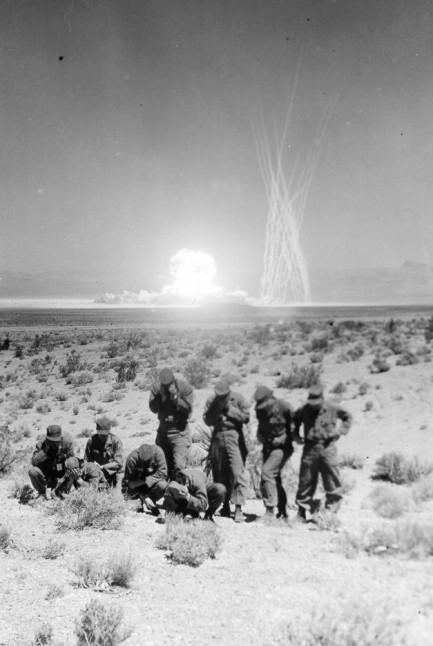 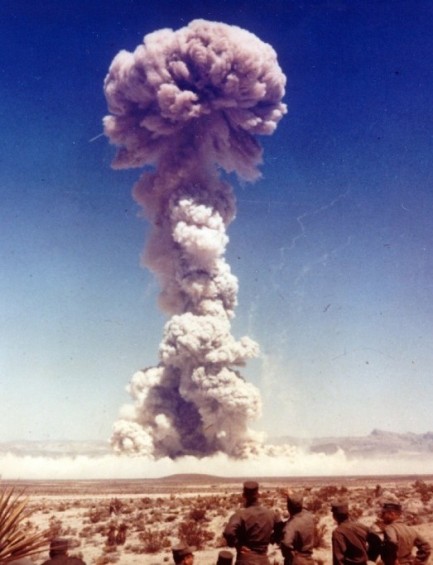
Above, two photos of the 22-kiloton nuclear test codenamed MET, part of the series Operation Teapot, detonated at Frenchman Flat, Nevada, with military observers first shielding their eyes, then regarding the debris cloud, today in 1955.

|
 |

The headlines that mattered yesteryear.
2003—Hope Dies
Film legend Bob Hope dies of pneumonia two months after celebrating his 100th birthday. 1945—Churchill Given the Sack
In spite of admiring Winston Churchill as a great wartime leader, Britons elect
Clement Attlee the nation's new prime minister in a sweeping victory for the Labour Party over the Conservatives. 1952—Evita Peron Dies
Eva Duarte de Peron, aka Evita, wife of the president of the Argentine Republic, dies from cancer at age 33. Evita had brought the working classes into a position of political power never witnessed before, but was hated by the nation's powerful military class. She is lain to rest in Milan, Italy in a secret grave under a nun's name, but is eventually returned to Argentina for reburial beside her husband in 1974. 1943—Mussolini Calls It Quits
Italian dictator Benito Mussolini steps down as head of the armed forces and the government. It soon becomes clear that Il Duce did not relinquish power voluntarily, but was forced to resign after former Fascist colleagues turned against him. He is later installed by Germany as leader of the Italian Social Republic in the north of the country, but is killed by partisans in 1945.
|

|
|

It's easy. We have an uploader that makes it a snap. Use it to submit your art, text, header, and subhead. Your post can be funny, serious, or anything in between, as long as it's vintage pulp. You'll get a byline and experience the fleeting pride of free authorship. We'll edit your post for typos, but the rest is up to you. Click here to give us your best shot.

|
|




















 meant to kill only people and leave buildings and infrastructure intact, which makes sense in upside-down military world, but not killing people? We're baffled.
meant to kill only people and leave buildings and infrastructure intact, which makes sense in upside-down military world, but not killing people? We're baffled.




 caused by global warming, add grisly corpses reappearing, and former hitmen virtue signaling about their carbon footprints. Which the mobster was too old to understand anyway. “Hybrid? You know I never worked with them! I never liked them, and I never trusted them!”
caused by global warming, add grisly corpses reappearing, and former hitmen virtue signaling about their carbon footprints. Which the mobster was too old to understand anyway. “Hybrid? You know I never worked with them! I never liked them, and I never trusted them!”













































































